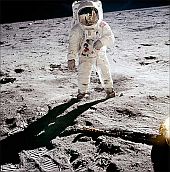 Supporters of the theory that NASA faked the Apollo moon landings have the tide turned against them, as a lunar orbiter has spied spacecraft and astronaut tracks on the Moon left behind almost 40 years ago.
Supporters of the theory that NASA faked the Apollo moon landings have the tide turned against them, as a lunar orbiter has spied spacecraft and astronaut tracks on the Moon left behind almost 40 years ago.
Apollo 12 astronauts Pete Conrad and Alan Bean set foot on the moon in November 1969, just a few months after Apollo 11 made history as the first manned moon mission.
Now, according to a report in the National Geographic News, the high-resolution camera aboard NASA's Lunar Reconnaissance Orbiter has spied the remnants of Conrad and Bean's 32-hour stay along the rim of what is now called Surveyor Crater.
Labeled arrows on the new image show where spacecraft parts still rest in vast lunar lava plain dubbed the 'Ocean of Storms'.
Arrows with no labels point to the dark trails of footprints that surround the descent stage of the Intrepid lunar lander, from which the astronauts conducted two spacewalks.
On their first excursion, the astronauts set up the Apollo Lunar Surface Experiment Package, or ALSEP, which sent data back to Earth for seven years after Apollo 12's return.
The next day, Conrad and Bean walked to Head, Bench, and Sharp craters, collecting rock samples and taking pictures along the way.
In total, the Apollo 12 mission brought back more than 70 pounds (32 kilograms) of lunar samples, which scientists used to study the region's age and composition.
In addition, a faint trail skirting Surveyor Crater marks the path the astronauts took to collect hardware from the unmanned Surveyor 3 craft, which had landed two years before, about 1,500 feet (450 meters) from the Apollo 12 site.
The astronauts brought some of Surveyor's parts back to Earth, so that NASA engineers could study the effects of long-term exposure to the moon's environment on the agency's instruments.





